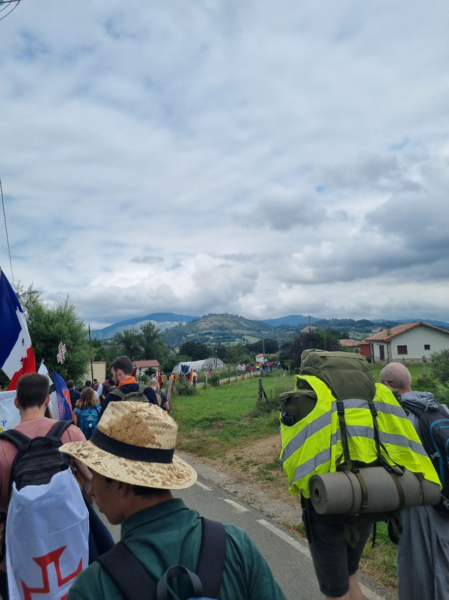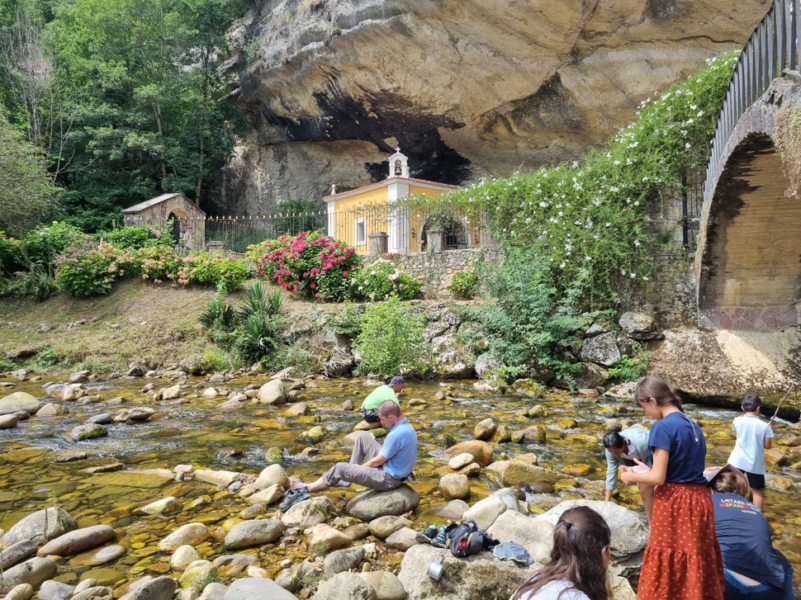Lagos de Covadonga, Asturias, Spain. Photo by Kamila Maciejewska on Unsplash.
Editor’s note: for our Hispanidad archive, click here.
Friday 21st July
For anyone that has seen or visited most of Spain, the province of Asturias is immediately, and somewhat starkly, in contrast to the landscape and climate that one might have expected, and indeed predominates in much of the country. Rather than the sunbaked plateaus and olive groves of the rest of the peninsula, here in ‘España Verde’ (green Spain) I gaze on lush green pastures, forests and mist-shrouded mountains from my coach as it winds its way from the airport, through the valleys, to the medieval capital of Oviedo. For this Englishman such a climatic transition from the rather damp English summer we have been having was reassuringly seamless.
On arrival in Oviedo, my first task was to rendezvous with the other pilgrims of my chapter – Heilige Willibrord. Formed under the patronage of the seventh and eighth-century Anglo-Saxon missionary, Willibrord – the ‘Apostle to the Frisians’ – who evangelized that people in cooperation with Charles Martel of the Franks and became the first Bishop of Utrecht, this chapter had been suggested to me by the pilgrimage organisers as the Dutch and Belgian pilgrims spoke reliably excellent English. Our Anglo-Dutch patronage also seemed highly fitting. It was a delight to meet my fellow chapter members for a cold cerveza beer at the plaza in front of Oviedo’s gothic Cathedral of San Salvador, where we would begin our pilgrimage the next morning. Our chaplain was Fr Elias Leyds CSJ, founder of EWTN Low Countries, who I found to be both pastorally down-to-earth and intellectually interesting. After a fortifying pre-pilgrimage dinner of paella and rioja we settled in for an early night ahead of reveille at dawn.
Saturday 22nd July, Feast of St Mary Magdalene
Dawn saw the incongruous sight of throngs of pilgrims streaming through the old city to the Cathedral plaza passing by the last Friday night secular revellers returning home, as we assembled for the Blessing of the Pilgrims by the archbishop. Never exactly quiet, the Spanish pilgrims were jovial and chirpy as ever even before the sun rose.
Hundreds of pilgrims gather outside the Cathedral of San Salvador in Oviedo for Holy Mass before our departure pic.twitter.com/D6IYRli0tO
— OnePeterFive (@OnePeterFive) July 22, 2023
With only eight members, our chapter Heilige Willibrord was one of the smallest chapters on the pilgrimage but this allowed us to get good positions during the blessing and masses. There were some 1,200 pilgrims from all over Spain, significant contingents from France and Portugal, as well as small groups from other nations, and almost all included many families and young people.
The assembled pilgrims then received an episcopal blessing from Archbishop Jesús Sanz of Oviedo, who would not permit the Apostolic Roman Rite in ‘his’ cathedral, but spoke some words on the difficulties in secular Spain today and the need for a “new Reconquista” to begin in our hearts. Unlike the Chartres pilgrimage, where it takes most of the first day to leave the metropole of Paris, the procession of chapters passed through the old town of Oviedo and into the countryside within half an hour. The statue of Our Lady of Covadonga was ever at the fore, followed by the numerous priests and religious on the pilgrimage.
Though our chapter was small we were not to be outdone in the singing that swelled as we walked and carried us into the foothills. I quickly became familiar with the Hail Mary in Dutch – much like English Catholics, my Dutch friends, though few in number and coming from a historically Protestant nation, were keen to show our Spanish hosts that there was Catholic life in the Low Countries. Just as we English Catholics must acknowledge the “unpaid bill” (credit to Fr Leyds for the term) of our nation’s apostasy and the massive theft of Church property, so these Dutch acknowledge the “unpaid bill” of the seditious Calvinist Dutch revolt against Philip II of Spain, Lord of the Seventeen Provinces of the Netherlands in the late sixteenth century. Such was the vigour of our singing (it seemed) that after a few miles the Portuguese chapter of Nossa Senhora De Fátima joined us in our sung Rosary and stayed close by throughout our pilgrimage. The international friendships that arise on these pilgrimages are one of the many joys that I have come to appreciate.
The terrain gently undulated through rich green countryside for the first day, passing through orchards and villages of small holdings, many with the characteristic elevated and slightly squat Asturian granaries – the hórreos. We covered well over 20 miles this day and our campsite was a welcome sight.

Sunday 23rd July, Eighth Sunday after Pentecost
Despite the overall and necessary spirit of penance on our pilgrimage, the weather was merciful to us on Sunday with the lingering grey clouds only depositing a fine and refreshing mist of rain as we set out in the morning. It was just as well since today would be the hardest day of walking as we made our way deeper into the hills and eventually the mountains of the Asturian Massif.
The day became hot and humid and the mountains were daunting. It was nevertheless something of a helpful metaphor for the spiritual life we might hope for, there were ups and downs but overall, we were gradually ascending! I wasn’t given to complain – one of our number, a tough Dutch marine, was carrying all fifty pounds of his camping gear on his back up the mountains! As always with long pilgrimages, what I perhaps most savoured, after the Sacraments, was how simple life becomes when walking, praying and singing. The only worldly objective we had was to reach our camp and to continue the next day until we reached the Sanctuary of Covadonga. All other frenetic worldly concerns and cares simply fall away in that time and one truly inhabits an almost timeless ‘pre-modern’ frame of mind.
Occasionally, our route took us through Tolkienesque temperate rainforests thick with mosses, lichens, and primordial oaks. Just as the day became hottest, we arrived at our lunch stop at the Sanctuary of the Virgin of the Cave. We were able to enjoy some precious moments praying at the chapel of Our Lady and cooling our feet in the deliciously cool mountain stream.

After lunch we passed through the nearby town of Infiesto. Here the chapters’ singing dies down and I learn that the town’s Communist mayor has forbidden any singing from the pilgrimage passing through. We receive somewhat frosty looks from some of the citizens but did our best to sanctify the town with our prayers for its residents and for the new Reconquista instead.
Our second camp was in a beautiful valley with mountains rising on all sides (see 0:04 and 1:06 in the 2023 pilgrimage trailer).
Here we congregated for our Sunday Solemn High Mass with the setting sun behind us. One aspect of the Spanish pilgrimage masses that I immediately noticed was the triumphant instrumental music during the Consecration. This was the Marcha Real (“Royal March”), the anthem of Spain, and a fittingly glorious salutation for the coming of Christ the King. I since learned of another custom during this typically Spanish expression of the Faith from a Carlist friend; it is customary for any flags present to be turned upside down at the moment of the Marcha Real and the coming of the King, a gesture otherwise reserved for final surrender on the battlefield.
Monday 24th July, Mass of Our Lady of Covadonga
Our final day of walking, also the shortest day, took us deeper into the mountains. With high peaks and natural vantage points one could see how this had been ideal country for the Christian Hispano-Romans to have retreated to conduct a seemingly last-ditch guerilla war against the Moors. A combination of crisp Asturian apples and the signs indicating our nearby destination continued to lift our spirits for the final stretch. We were approaching the cradle of Spain.
When we ascended the final road and arrived at the Sanctuary of Covadonga the singing and jubilation of the Spanish chapters easily rivalled that of the famous and larger Chartres pilgrimage. Like all places blessed by the presence of Our Lady the atmosphere of the Sanctuary was indescribably peaceful and beautiful. Our pilgrimage concluded with a final journey along the cave tunnel to the Cave of Covadonga itself where Don Pelayo had placed a statue of Our Lady and asked for her special protection as he and the Asturian Christians prepared for their crucial battle in 720AD.
It is clear to see why this mountainous country would be an ideal retreat for the Visigothic Christians to conduct a seemingly last resistance against the Moors. pic.twitter.com/x9qNmRqHie
— OnePeterFive (@OnePeterFive) July 24, 2023
The third of our pilgrimage masses, in the Basilica of Covadonga was undoubtedly the most magnificent. Here is the sweet Eucharistic hymn “Adoro te devote” by St Thomas Aquinas, during the distribution of Holy Communion:
With the continued prayers for a restoration of Cristiandad, rooted in the celebration of the Mass of Ages, I could not help but have hope that there is still life in Catholic Spain. The situation for the Hispano-Romans under Don Pelayo seemed hopeless and so does ours. But in seeking the intercession and protection of Our Lady they fulfilled the most important action for militant Catholics, one repeated throughout history. Hence, the basic ‘formula’ of the pilgrimage – penance, the Traditional Mass, prayers for a restored Christian social order, and returning to where the Spanish nation began in order to beseech the intercession of Our Lady of Christendom for the graces for a new Reconquista are exactly what we need.
¡Viva España católica!
Laudate Maria!
Viva Cristo Rey!
See the trailer for the 2023 Pilgrimage of Nuestra Señora de la Cristiandad here:


